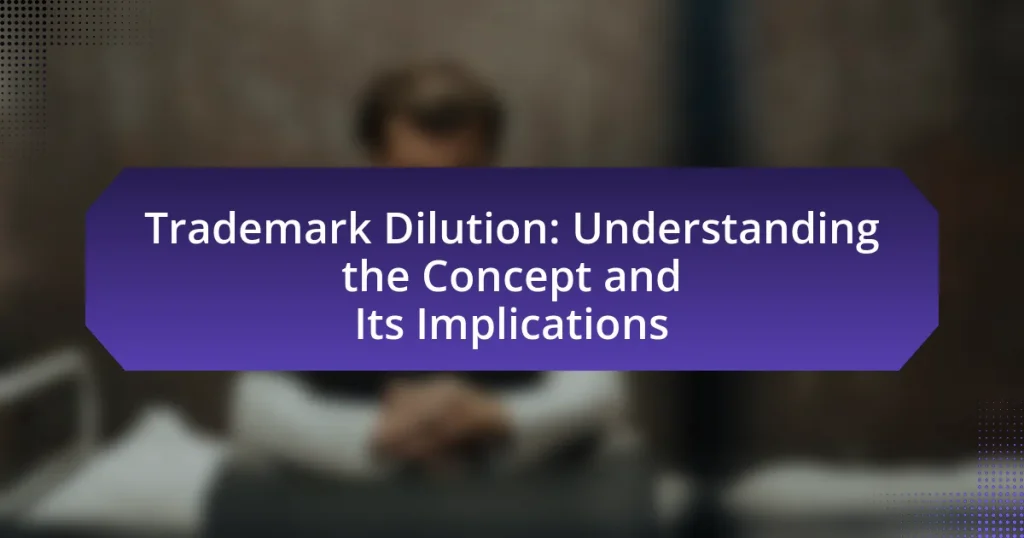Trademarks are essential intangible assets in mergers and acquisitions (M&A), significantly impacting company valuation and negotiation processes. They enhance brand identity, consumer recognition, and market position, often leading to higher premiums in M&A transactions. The article explores how trademarks influence valuation, the factors determining their worth, and the legal protections they provide. It also addresses the challenges and risks associated with trademark disputes during M&A, emphasizing the importance of thorough due diligence and strategic integration of trademark portfolios to mitigate potential liabilities and enhance brand equity post-acquisition.

What is the role of trademarks in mergers and acquisitions?
Trademarks play a crucial role in mergers and acquisitions by serving as valuable intangible assets that can significantly influence the valuation and negotiation processes. They represent brand identity and consumer recognition, which can affect market position and competitive advantage post-merger. For instance, a strong trademark can enhance the perceived value of a company, as evidenced by the fact that brands like Coca-Cola and Apple have substantial market capitalizations largely attributed to their trademarks. Additionally, due diligence in M&A transactions often includes assessing the strength and validity of trademarks to ensure that the acquiring company can leverage these assets effectively without infringing on existing rights. This assessment helps mitigate risks associated with brand dilution or legal disputes, thereby facilitating smoother transitions and integration processes.
How do trademarks influence the valuation of a company during M&A?
Trademarks significantly influence the valuation of a company during mergers and acquisitions by enhancing brand recognition and customer loyalty, which can lead to increased revenue potential. A strong trademark portfolio can provide a competitive advantage, making the company more attractive to potential buyers. For instance, companies with well-established trademarks often command higher premiums in M&A transactions, as evidenced by a study from the International Trademark Association, which found that brands contribute up to 30% of a company’s overall value. This demonstrates that trademarks are not merely legal assets but vital components that can substantially affect financial assessments in M&A scenarios.
What factors determine the value of trademarks in an acquisition?
The value of trademarks in an acquisition is determined by factors such as brand recognition, market position, legal protection, and revenue generation potential. Brand recognition reflects consumer awareness and loyalty, which can significantly enhance a trademark’s value. Market position indicates the trademark’s competitive advantage within its industry, influencing its desirability during an acquisition. Legal protection, including registration and enforcement of trademark rights, ensures the trademark’s exclusivity and longevity, adding to its value. Revenue generation potential assesses the trademark’s ability to contribute to sales and profitability, often evaluated through historical financial performance and projected future earnings. These factors collectively establish the overall worth of trademarks in the context of mergers and acquisitions.
How do trademark registrations impact the negotiation process?
Trademark registrations significantly influence the negotiation process in mergers and acquisitions by establishing legal ownership and exclusive rights to a brand. This legal protection enhances the value of the business being acquired, as registered trademarks can serve as valuable intangible assets that contribute to the overall valuation of the company. Furthermore, the presence of registered trademarks can streamline negotiations by reducing the risk of disputes over brand identity and usage, thereby fostering a more straightforward dialogue between parties. For instance, a study by the International Trademark Association indicates that companies with strong trademark portfolios often command higher premiums during acquisition negotiations, highlighting the financial impact of trademark registrations on deal-making.
Why are trademarks considered critical assets in M&A transactions?
Trademarks are considered critical assets in M&A transactions because they represent brand identity, customer loyalty, and market value. A strong trademark can significantly enhance a company’s competitive advantage and contribute to its overall valuation during mergers and acquisitions. For instance, a study by the International Trademark Association found that companies with well-recognized trademarks can command higher premiums in M&A deals, as these trademarks often signify established goodwill and consumer trust. This intrinsic value makes trademarks essential for assessing the financial health and future potential of the acquiring or target company.
What legal protections do trademarks provide to acquiring companies?
Trademarks provide acquiring companies with legal protections that safeguard brand identity and prevent consumer confusion. These protections include exclusive rights to use the trademark in commerce, which helps maintain the value of the acquired brand and its reputation. Additionally, trademarks can deter competitors from using similar marks that could mislead consumers, thereby preserving market share and customer loyalty. The Lanham Act in the United States, for example, establishes these rights and allows trademark owners to take legal action against infringement, reinforcing the importance of trademarks in maintaining the integrity of a business during mergers and acquisitions.
How do trademarks contribute to brand equity in mergers?
Trademarks significantly enhance brand equity in mergers by providing established recognition and consumer trust. When two companies merge, the existing trademarks of both entities can leverage their brand equity, which is the value derived from consumer perception and loyalty. For instance, a strong trademark can lead to increased market share and customer retention, as seen in the merger of Disney and Pixar, where both brands maintained their distinct identities while benefiting from combined brand equity. This synergy often results in higher valuation and competitive advantage in the marketplace, as evidenced by studies showing that brands with strong trademarks can command premium pricing and foster customer loyalty.
What challenges arise regarding trademarks in the M&A process?
Challenges regarding trademarks in the M&A process include potential conflicts over trademark ownership, the need for thorough due diligence, and the risk of trademark dilution. During M&A transactions, acquiring companies must verify that the trademarks are properly registered and free of encumbrances, as unresolved disputes can lead to legal complications. Additionally, if the acquired company’s trademarks are not adequately protected or if they are similar to existing trademarks of the acquiring company, this can result in brand confusion and dilution, impacting market positioning. According to a study by the International Trademark Association, 50% of M&A transactions face issues related to intellectual property, including trademarks, highlighting the importance of addressing these challenges proactively.
What are the risks of trademark infringement during mergers?
Trademark infringement during mergers poses significant risks, including legal disputes, financial liabilities, and damage to brand reputation. When two companies merge, the potential for confusion over similar trademarks increases, which can lead to lawsuits from trademark holders asserting their rights. For instance, if a merged entity uses a trademark that closely resembles an existing one, it may face claims of dilution or unfair competition, resulting in costly litigation. Additionally, the financial implications can be severe, as companies may incur expenses related to legal fees, settlements, or rebranding efforts. Furthermore, the negative publicity from trademark disputes can harm consumer trust and brand equity, impacting the merged company’s market position. These risks underscore the importance of thorough trademark due diligence during the merger process to identify and mitigate potential infringement issues.
How can trademark disputes affect the success of an acquisition?
Trademark disputes can significantly hinder the success of an acquisition by creating legal uncertainties and potential financial liabilities. When a trademark dispute arises, it can lead to prolonged litigation, which delays the acquisition process and increases costs for both parties involved. For instance, if the acquiring company faces a challenge regarding the validity of a trademark owned by the target company, it may need to allocate resources to resolve the dispute, diverting attention from integration efforts. Additionally, unresolved trademark issues can affect brand reputation and market positioning, ultimately impacting the perceived value of the acquisition. Historical examples, such as the 2014 acquisition of Beats by Apple, illustrate how trademark disputes can complicate negotiations and lead to adjustments in deal terms or even abandonment of the acquisition.

How do companies assess trademark portfolios in M&A?
Companies assess trademark portfolios in M&A by conducting thorough due diligence, which includes evaluating the strength, scope, and market relevance of the trademarks. This assessment involves analyzing trademark registrations, usage, potential infringements, and the overall brand equity associated with the trademarks. For instance, a study by the International Trademark Association indicates that strong trademark portfolios can significantly enhance a company’s valuation during M&A transactions, as they represent not only legal rights but also consumer recognition and loyalty. Additionally, companies often employ trademark audits to identify any risks or liabilities associated with the trademarks, ensuring that they align with the strategic goals of the merger or acquisition.
What methods are used to evaluate trademark strength and relevance?
Methods used to evaluate trademark strength and relevance include distinctiveness assessment, market recognition analysis, and legal protection evaluation. Distinctiveness assessment categorizes trademarks into four levels: generic, descriptive, suggestive, and arbitrary/fanciful, with stronger protection afforded to the latter two categories. Market recognition analysis involves measuring consumer awareness and association of the trademark with specific goods or services, often through surveys or sales data. Legal protection evaluation examines the trademark’s registration status, history of enforcement, and potential for dilution or infringement, which can impact its overall strength and relevance in the marketplace. These methods collectively provide a comprehensive understanding of a trademark’s position and value, particularly in the context of mergers and acquisitions.
How does market presence influence trademark assessment?
Market presence significantly influences trademark assessment by establishing the recognition and reputation of a brand within its industry. A strong market presence indicates that a trademark is associated with specific goods or services, which can enhance its distinctiveness and protectability. For instance, trademarks that are widely recognized in the marketplace are less likely to be deemed generic or descriptive, thereby increasing their legal standing. According to the United States Patent and Trademark Office, trademarks that demonstrate substantial use in commerce can achieve a higher level of protection under trademark law, as evidenced by cases where established brands successfully defended their trademarks against infringement due to their strong market presence.
What role does consumer recognition play in trademark evaluation?
Consumer recognition is crucial in trademark evaluation as it directly influences brand value and market perception. High levels of consumer recognition indicate that a trademark is well-established, which can enhance its worth during mergers and acquisitions. For instance, a study by the International Trademark Association found that brands with strong consumer recognition can command a premium price in acquisition deals, reflecting their established market presence and customer loyalty. This recognition serves as a key indicator of a trademark’s strength and potential for future profitability, making it a vital factor in the evaluation process.
How can due diligence mitigate trademark-related risks in M&A?
Due diligence can mitigate trademark-related risks in mergers and acquisitions by thoroughly assessing the target company’s trademark portfolio, including ownership, registration status, and potential infringements. This process identifies any existing legal disputes or challenges related to trademarks, which could affect the value and usability of the brand post-acquisition. For instance, a study by the International Trademark Association indicates that 70% of companies that conducted comprehensive trademark due diligence reported fewer post-acquisition disputes. By uncovering these risks early, acquiring companies can negotiate better terms, allocate resources for potential litigation, or even decide against the acquisition if the risks are deemed too high.
What steps should be taken during trademark due diligence?
During trademark due diligence, the primary steps include conducting a comprehensive trademark search, reviewing trademark registrations and applications, assessing the scope of trademark rights, evaluating potential conflicts, and analyzing the trademark’s market presence.
A comprehensive trademark search identifies existing trademarks that may conflict with the subject trademark, ensuring that the acquiring entity is aware of any potential legal issues. Reviewing trademark registrations and applications confirms the validity and ownership of the trademarks, while assessing the scope of trademark rights clarifies the extent of protection and any limitations. Evaluating potential conflicts involves analyzing similar trademarks in related markets to mitigate infringement risks. Lastly, analyzing the trademark’s market presence provides insights into its reputation and value, which are critical during mergers and acquisitions.
These steps are essential to minimize legal risks and ensure a smooth transition during the acquisition process.
How can companies identify potential trademark liabilities?
Companies can identify potential trademark liabilities by conducting comprehensive trademark searches and audits. These processes involve reviewing existing trademarks, assessing their registration status, and analyzing potential conflicts with third-party trademarks. For instance, the United States Patent and Trademark Office (USPTO) provides databases that can be utilized to check for similar trademarks that may pose a risk of infringement. Additionally, companies should evaluate their trademark usage in marketing materials and products to ensure compliance with trademark laws. This proactive approach helps mitigate risks associated with trademark disputes, which can lead to costly litigation and damage to brand reputation.

What best practices should companies follow regarding trademarks in M&A?
Companies should conduct thorough trademark due diligence during mergers and acquisitions to identify potential risks and opportunities. This involves assessing the strength, registration status, and geographic coverage of trademarks held by both parties. Additionally, companies should ensure that trademarks are properly assigned and that any licensing agreements are reviewed to avoid future disputes. According to the International Trademark Association, 70% of companies that fail to address trademark issues during M&A face significant legal challenges post-transaction. Therefore, integrating trademark strategies into the overall M&A process is essential for protecting brand value and ensuring a smooth transition.
How can companies effectively integrate trademark portfolios post-acquisition?
Companies can effectively integrate trademark portfolios post-acquisition by conducting a comprehensive audit of both the acquiring and acquired company’s trademarks to identify overlaps, gaps, and opportunities for consolidation. This process involves assessing the strength, market presence, and legal status of each trademark, which allows companies to streamline their portfolios and eliminate redundancies. For instance, a study by the International Trademark Association highlights that a well-executed trademark integration strategy can enhance brand recognition and reduce legal risks associated with trademark disputes. Additionally, establishing a unified trademark management system facilitates consistent branding and ensures compliance with regulatory requirements, ultimately leading to a more cohesive market presence.
What strategies enhance brand alignment after a merger?
Effective strategies that enhance brand alignment after a merger include establishing a unified brand vision, integrating marketing efforts, and engaging employees in the rebranding process. A unified brand vision ensures that both companies share a common identity and purpose, which is crucial for customer perception and loyalty. Integrating marketing efforts allows for a cohesive message across all platforms, reinforcing the new brand identity to consumers. Engaging employees in the rebranding process fosters a sense of ownership and commitment, which can lead to better customer service and brand representation. Research indicates that companies that prioritize brand alignment during mergers experience a 20% increase in customer retention rates, demonstrating the importance of these strategies in achieving successful brand integration.
How can companies leverage trademarks for market expansion post-M&A?
Companies can leverage trademarks for market expansion post-M&A by utilizing the established brand recognition and customer loyalty associated with their trademarks. This strategy allows companies to enter new markets more effectively, as strong trademarks can facilitate consumer trust and reduce perceived risk. For instance, a study by the International Trademark Association indicates that companies with well-recognized trademarks experience a 20% higher market penetration rate in new regions compared to those without. By integrating and promoting their trademarks in marketing efforts, companies can enhance their visibility and appeal in diverse markets, ultimately driving growth and increasing market share.
What are common pitfalls to avoid with trademarks in M&A?
Common pitfalls to avoid with trademarks in M&A include failing to conduct thorough due diligence, neglecting to assess trademark registrations and usage, and overlooking potential conflicts with existing trademarks. Due diligence is crucial as it helps identify any existing issues related to trademark ownership, validity, and potential infringements. For instance, a lack of comprehensive trademark audits can lead to the acquisition of trademarks that are not enforceable or are subject to litigation. Additionally, not evaluating the strength and market recognition of the trademarks can result in overestimating their value, which can adversely affect the overall valuation of the deal. Lastly, ignoring the need for proper assignment and transfer of trademarks during the transaction can lead to legal complications post-acquisition, jeopardizing the brand’s integrity and market position.
How can neglecting trademark issues lead to post-merger challenges?
Neglecting trademark issues can lead to significant post-merger challenges, including brand confusion and legal disputes. When companies merge, their trademarks may overlap or conflict, resulting in consumer uncertainty about brand identity. For instance, if two companies with similar trademarks do not address these issues, they may face lawsuits from trademark holders, which can disrupt operations and incur legal costs. Additionally, failure to properly assess and integrate trademark portfolios can lead to lost market value and diminished brand equity, as seen in cases where merged entities struggle to establish a unified brand presence. Thus, addressing trademark issues proactively is essential to mitigate these risks and ensure a smooth transition post-merger.
What lessons can be learned from past M&A trademark failures?
Lessons from past M&A trademark failures highlight the importance of thorough due diligence and strategic brand integration. Companies like Quaker Oats faced significant challenges when acquiring Snapple, primarily due to a lack of understanding of the brand’s market position and consumer perception, leading to a $1.7 billion write-off. Additionally, the failure of the merger between AOL and Time Warner illustrates the risks of neglecting trademark alignment and brand identity, resulting in a loss of $99 billion in market value. These cases emphasize that successful M&A requires not only financial assessment but also a comprehensive evaluation of trademark assets and their alignment with corporate strategy.
What practical tips can companies implement for trademark management in M&A?
Companies can implement several practical tips for trademark management in mergers and acquisitions (M&A) to ensure effective integration and protection of their intellectual property. First, conducting a comprehensive trademark audit before the M&A process helps identify all existing trademarks, their statuses, and potential conflicts. This audit should include a review of registrations, applications, and common law rights to assess the full scope of trademark assets.
Second, companies should evaluate the trademark portfolios of both entities involved in the M&A to identify overlaps and gaps. This evaluation allows for strategic decisions regarding which trademarks to retain, abandon, or rebrand, ensuring that the combined entity maintains a strong and coherent brand identity.
Third, establishing clear protocols for trademark usage and enforcement post-M&A is crucial. This includes defining how trademarks will be used in marketing and communications, as well as setting guidelines for monitoring and addressing potential infringements.
Additionally, companies should consider the implications of jurisdictional differences in trademark laws, especially if the M&A involves international entities. Understanding these differences can help in navigating registration and enforcement challenges across various markets.
Finally, involving legal experts specializing in intellectual property during the M&A process ensures that all trademark-related issues are addressed adequately, minimizing risks and maximizing the value of the trademark assets involved.



